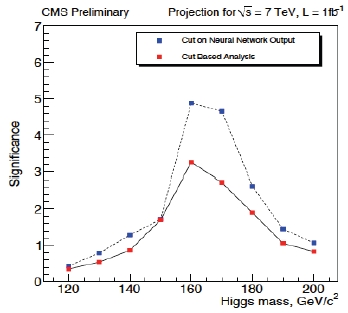The results presented in the graph I published in that post were shown as a "discovery reach", i.e. by showing how significant would be a Higgs signal of a given mass. A reader asked in the comments thread what do CMS and ATLAS predict they can obtain at the end of next year, by which time they predict to have collected one inverse femtobarn of proton-proton collisions at 7 TeV centre-of-mass energy. I decided I would quickly answer with a separate posting, this one.
CMS and ATLAS have produced in the past a full set of predictions for their discovery reach by running at 14 TeV of energy. The temporary running at 7 TeV forced a revision of those predictions, which the experiments have produced for a subset of the search channels, the most sensitive ones, which involve diboson final states: the decay of the Higgs to diphotons, WW, and ZZ pairs.
So what should we expect ? You can get some information in the figure below, courtesy ATLAS collaboration.

The figure shows the exclusion reach of ATLAS (at 95% confidence level) as a function of Higgs boson mass. A given Higgs mass can be excluded by searches involving diboson decays by ATLAS, with 1/fb of data at 7 TeV, if the hatched curve goes below the line at y=1. You thus gather that ATLAS expects to exclude single-handedly a Higgs boson in the approximate range 136-190 GeV, if that particle has a different mass or if it does not exist. Also note that a "unlucky" wholesome 1-sigma upward fluctuation of backgrounds might shrink that exclusion region considerably (just take the border between upper green and upper yellow bands and see where it crosses the y=1 line); a wholesome 1-sigma downward fluctuation of the data might instead enlarge the exclusion region, but the effect would not be as dramatic.
Of course, we should note that the combination of CMS results with ATLAS one would strongly fortify these results; also, the inclusion of low-mass search channels, such as the decay to tau pairs, is going to significantly improve the reach. So it is not really fair to compare these results with those of an extended Tevatron run.
 So far we have only discussed 95% confidence level limits. The obvious question is then, what is the discovery reach with 1/fb ? This is a quite different matter from limit-setting, although the analysis methods are for the most part the same. The CMS experiment has produced an estimate of the significance of a Higgs signal as a function of Higgs boson mass, for 1/fb analyses. Again, these are single-experiment predictions and they are only indicative of things to come. You can see the result of the exercise on the graph on the right.
So far we have only discussed 95% confidence level limits. The obvious question is then, what is the discovery reach with 1/fb ? This is a quite different matter from limit-setting, although the analysis methods are for the most part the same. The CMS experiment has produced an estimate of the significance of a Higgs signal as a function of Higgs boson mass, for 1/fb analyses. Again, these are single-experiment predictions and they are only indicative of things to come. You can see the result of the exercise on the graph on the right.Two analyses are considered for the significance curves in the figure: a simple one (red curve) and a more multivariate-oriented one, based on Neural Networks (in blue). You can see that one single experiment at the LHC, with just one inverse femtobarn of data, and with only a part of the possible analyses, can still reach 3-sigma significances in the 150-180 GeV range, roughly speaking. Of course the significance at lower mass is much smaller, but that is at least partly due to the neglecting of decay channels that are more sensitive in that region.
I think the CMS and ATLAS projections are a bit less refined than the Tevatron ones I discussed in the previous article, and I am actually happy that it is so: the LHC experiments do not need to spend their time trying to convince anybody of what they can do as far as the Higgs search of next year is concerned: they will just do it. And I believe that the results will far exceed today's rosiest expectations, because what expectations cannot factor in are the advancements in analysis strategies and experimental tricks that 5000 brilliant minds can together produce!
For more details of the Higgs prospects at the LHC, please see the slides of Chiara Mariotti's talk at LHC Days in Split.




Comments